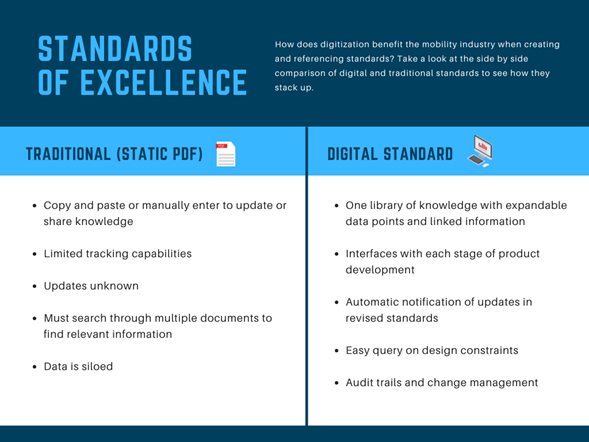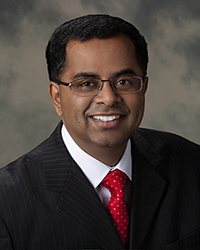Digital Standards are Our Future
By Raman Venkatesh
Posted: September 1, 2022
Many industries are digitally transforming at a rapid pace—and the multitude of industries that we call ‘mobility’ is leading the transformation in all forms of transportation, whether we move people or goods. As we look at the digital transformation at SAE International, we are investing to stay ahead of the curve.
For our work, that starts with digital standards.
This is not a new venture for SAE. Since 2016, we’ve had resources available digitally through our SAE Mobilus platform, the definitive online library for SAE Standards—updated in real-time—that serves as a single point of access to timely technical content for the modern engineer. This platform prioritizes the user experience to make searching more efficient and accessible.
But true digitization is more than just going from paper to PDFs.
Digital standards enable a user to pull data and requirements from a standard into the tools they use to develop their products. Whether it is a requirements-tracking system, a model-based simulation tool, or some other tool used during the product life cycle. The data is referenceable and reusable to support multiple use cases.
We need to think critically about the problems industry is facing—and how digital solutions can help solve them.
One relevant and high-economic-cost example is the impact of product development challenges due to supply chain disruption. Many companies have struggled with the unavailability of parts and components they need to create their products. As a result, some companies have had to redesign their products or make unequal substitutions. Other companies have found they need to revisit the design of products not yet released to safeguard against the disruptions seen in the supply chain.
Because the interconnectivity of the product development cycle relies on many departments -- many of which tend to be siloed -- ad-hoc workarounds are often implemented, resulting in the duplication of work and potential errors as static information is passed around. These longer, more expensive product development cycles stymie innovation as comprehensive tracking remains elusive.
In the standards world, this becomes complicated when you are following multiple standards, sometimes from different origins that reference other documents. Standards also tend to be of different types depending upon industry norms, data styles and types and user expectations. Digitizing them all to make them seamlessly integrated with industry ERP or design and engineering systems are a multi-dimensional challenge. However, it is entirely worth it when you consider the rewards. When combining digital requirements from standards with other requirements, you can build a digital twin, or a digital representation of your system that shows the history of how you have gotten to the final point of product development.
You can’t do that with the static PDFs of the past.
When done manually, there is risk of errors in transferring information across discrete PDFs into an enterprise-level ERP system that drives core design, development and engineering, leading to production and post-launch support systems. Such errors can cost tens of millions of dollars when not corrected early enough and can cause significant delays in development and launch, introducing significant opportunity cost in terms of lost revenues and market traction. Digital standards offer the potential to seamlessly embed critical technical information into product development lifecycles, allowing the engineers and leaders to focus on what matters most – getting to the right product at the right time at the right cost.
DIGITAL vs. TRADITIONAL STANDARDS
So, what makes a digital standard such a great tool?
The table below highlights some of the key differences between a digital standard and traditional approach.

With the time savings from using digital standards, companies can achieve enormous benefits to ROI. By reducing time spent searching for information, eliminating rework due to data entry errors and reducing the number of necessary physical prototypes through digitization, the savings add up. Mid-to large-size companies can save up to $1.5 million in time efficiency savings and cost savings. This includes the following:
- Time savings to minimize/eliminate the parsing of requirements from standards
- Time savings to search for relevant standards
- Eliminating time spent re-entering data to multiple systems (speaks to reuse of digital requirements)
- Eliminating rework due to data entry errors
- Reducing time required to prepare for audits
- Reducing the number of physical prototypes needed (assumimg digital requirements are used in combination with MBSE models)
- Reducing need for/production of custom parts
The potential doesn’t stop there, either.
Choosing to standardize rather than customize allows you to search by materials by dimensions, composition, and materials properties. This can reduce the number of parts, time, and cost that you’re putting in through the development process as you prepare to go to market.
Digital standards systems also have multiple integration options. With a fully digital set of requirements, your documents can work with each other across teams and eliminate some of the built-up silos that can naturally occur when working in a hybrid or fully offline model.
As a neutral convener of industry and the world’s authoritative source of advanced engineering standards, you can imagine how exciting this is for SAE as we think of the enhanced possibilities to work together across mobility sectors.
It’s past time to implement digital solutions to modern mobility problems. When we do this, we all can collectively advance mobility knowledge and solutions for the benefit of humanity.
And I, for one, can’t wait to see the exciting future enabled by digital standards.
About Raman Venkatesh

Raman Venkatesh, Ph.D., is the Executive Vice President and Chief Operating Officer of SAE International (SAEI). Dr. Venkatesh is responsible for strategy and global operations of SAEI generating close to $100 million in revenues as well as providing leadership to SAEI’s international staff of 350 professionals dedicated to advancing global mobility and design engineering. In addition, he oversees major business development and strategic alliances, including M&A and joint ventures.
Dr. Venkatesh was appointed as VP – Americas for FISITA and serves on the FISITA Executive Leadership Committee and is a member of the advisory board for the Swanson School of Engineering at University of Pittsburgh. He also serves on the boards of SAEI’s subsidiary companies, including as Chairman of SAE Media Group.
Prior to joining SAEI, Dr. Venkatesh was the CEO of a strategic business unit in Eureka Forbes Ltd., a consumer products company with operations across Asia and Europe. Previously, he was the Director of New Business Development for the American Chemical Society, a $600 million+ organization based in Washington, DC, serving a broad scientific enterprise. He earlier served on the boards of four companies, including as chairman of a technology joint venture in India.
The author gratefully acknowledges the contributions of Tory Irwin and Leslie McKay in developing this article.
